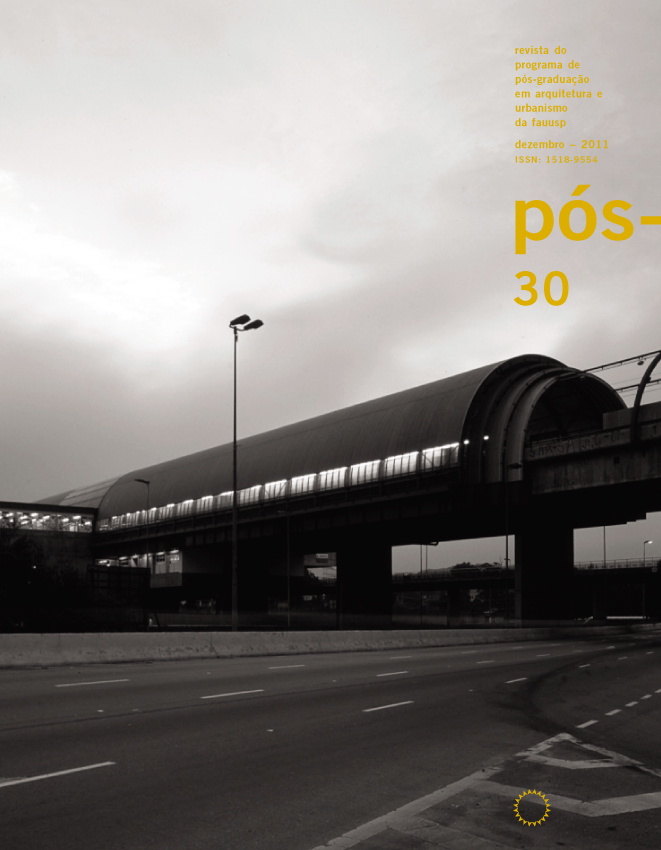Suburbia - metropolitanism in contemporary Portugal
DOI:
https://doi.org/10.11606/issn.2317-2762.v18i30p44-54Keywords:
Metropolitanism, Suburbia, PortugalAbstract
Vania Toledo photographed the Brazilian actors and celebrities who dotted the fancies of Portuguese television viewers in the years immediately following the Carnation Revolution of April 25, 1974. This social influence is analogous to a new urban yearning. Only in the periphery of cities was there the necessary space for creating a new life for these people. This desire for progress would affirmatively and optimistically guide the consolidation of the Portuguese government over the following decades, guiding Portugal's economy on a path leading into the European Union in 1986. It also formed the basis of domestic policy for a growing openness to the logic of European markets. In this context, we see cities spreading out to their suburban areas, transforming those territories into an urban sprawl of somewhat indistinct, anonymous clusters that overlapped the fields, creating the concept of the metropolitan area. The belief in some tangibility of the process, also motivated by the small size of architectural studios, held the intellectual debate away from public opinion. These studios focused on small scales and tried to compromise between the real possibilities of the national economy and the overwhelming growth of the suburbs. Siza Vieira delineated the guidelines of Portuguese architecture during this period. The precision of his designs combined the reasoning of several Portuguese architects. The sobriety of Siza's architecture, together with his restraint in the use of standard materials, limited an iconic appropriation of his work. The grandeur was replaced by a desire for delicacy, materialized around a formal synthesis extracted from an archeology of architecture itself.Downloads
References
DELEUZE, Gilles. El pliegue. Barcelona: Ediciones Paidos, 1989.
DOMINGUES, Álvaro. Cidade e Democracia, 30 anos de transformação urbana em Portugal. Lisboa: Universidade de Aveiro, 2006.
CARVALHO, Ricardo (Ed.). JÁ - Jornal dos Arquitectos, Lisboa: Ordem dos Arquiteto, n. 225, out.-dez. 2006.
FIGUEIRA, Jorge (Coord.) Álvaro Siza Modern Redux. São Paulo: Instituto Tomie Ohtake, 2008. Catálogo de exposição no Instituto Tomie Ohtake.
FUKUYAMA, Francis. O fim da História e o último homem: Aulyde Soares Rodrigues. Rio de Janeiro: Rocco, 1992.
GUERRA, Isabel; MATEUS, Augusto; PORTAS, Nuno. Plano Estratégico de Habitação 2008-2013. São Paulo: Instituto de Habitação e Reabilitação, 2008. (Relatórios 1, 2 e 3).
MOURA, Diógenes (Coord.). Vânia Toledo: Diário de bolsa: Instantâneos do Olhar. Fotografias. São Paulo: Pinacoteca do Estado de São Paulo, 2008. Catálogo de exposição.
SOLÀ-MORALES, Ignasi. Diferencias. Topografía de la arquitectura contemporánea. Barcelona: Editorial Gustavo Gilli, 1995.
SOLÀ-MORALES, Ignasi. Territórios. Barcelona: Editorial Gustavo Gilli, 2006.
TOLEDO, Vania. Meu vício é você... In: MOURA, Diógenes (Coord.). Vânia Toledo: Diário de bolsa: instantâneos do olhar: fotografias. São Paulo, 2008. p. 77. Catálogo de exposição na Pinacoteca do Estado de São Paulo.
TRIAS, Eugénio. Lógica del limite. Barcelona: Ensayos; Destino, 1991.
Downloads
Published
Issue
Section
License

This work is licensed under a Creative Commons Attribution 4.0 International License.
DIADORIM - Diretório de Políticas Editoriais












